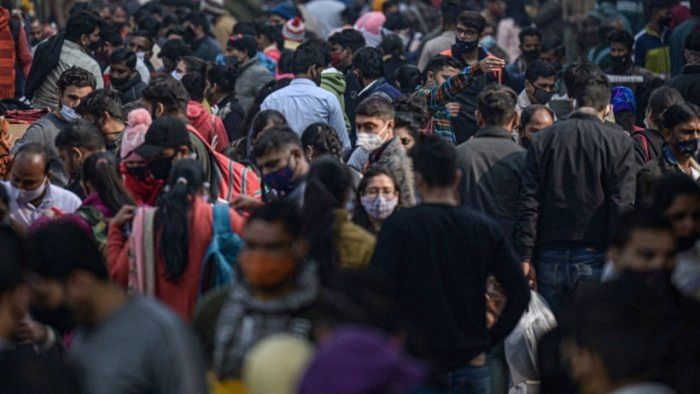
When the Omicron coronavirus variant spread through India late in December, Prime Minister Narendra Modi urged the nation to be vigilant and follow medical guidelines. Arvind Kejriwal, chief minister of the capital region of Delhi, swiftly introduced night curfews, shut down movie theatres and slashed restaurants and public transport to half capacity.
Then, both men hit the campaign trail, often appearing without masks in packed rallies of thousands.
“When it is our bread and butter at stake, they force restrictions and lockdowns,” said Ajay Tiwari, a 41-year-old taxi driver in New Delhi. “There are much bigger crowds at political rallies, but they don’t impose any lockdown in those areas. It really pains us deep in the heart.”
As Omicron fuels a rapid spread of new infections through India’s major urban hubs, the country’s pandemic fatigue has been intensified by a sense of déjà vu and the frustration of mixed signals.
It has been just a few months since the deadly Delta variant ravaged the country when government leaders vastly underestimated its threat and publicly flouted their own advice. The memories of overwhelmed hospitals and funeral pyres working around the clock are still all too fresh here.
The metropolis of Mumbai on Wednesday reported more than 15,000 new infections in 24 hours — the highest daily caseload since the pandemic began, beating the city’s previous record of about 11,000 cases during the second wave in the spring. In New Delhi, the number of daily infections increased by nearly 100% overnight.
The sheer size of India’s population, at 1.4 billion, has always kept experts wary about the prospects of a new coronavirus variant. In a few places around the world was the toll of the Delta as stark as in India. The country’s official figures show about 500,000 pandemic deaths — a number that experts say vastly undercounts the real toll.
Omicron’s high transmissibility is such that cases are multiplying at a dangerously rapid pace, and it appears to be ignoring India’s main line of defence: a vaccination drive that has covered about half the population. Initial studies show that the Oxford-AstraZeneca vaccine, a locally manufactured version of which has been used for about 90% of India’s vaccinations, does not protect against Omicron infections, though it appears to help reduce the severity of the illness.
Sitabhra Sinha, a professor of physics and computational biology at the Institute of Mathematical Sciences in Chennai, said his research into the reproduction rate of the virus — an indicator of how fast it is spreading that is called the “R-value” — in major cities like Delhi and Mumbai shows “insanely high” numbers for cities that had built decent immunity. Both had a large number of infections in the spring, and a majority of their adult populations have been vaccinated.
“Given this high R-value, one is looking at incredibly large numbers unless something is done to stop the spread,” he said.
But officials appear to be latching onto the optimism of the early indications from places like South Africa, where a fast spread of the variant did not cause devastating damage, rather than drawing lessons from the botched response to the Delta wave in the spring that ravaged India.
Dr. Anand Krishnan, a professor of epidemiology at the All India Institute of Medical Sciences in New Delhi, said India’s messaging of the new variant as “a mild illness” has led to complacency.
“The health system has stopped being complacent. But the population is complacent. People are not wearing masks or changing their behaviour,” Krishnan said. “They think it is a mild illness, and whatever restrictions are being imposed are seen more as a nuisance than necessary.”
Scientists say any optimism about Omicron is premature simply because of how many people the variant could infect.
“Even if it is a microscopic percentage who require hospitalisation,” Sinha said, “the fact is that the total population we’re talking about is huge.”
Although the percentage of newly infected people turning to hospitals has been increasing in recent days, data from India’s worst-hit cities — Mumbai, Delhi and Kolkata — showed that only a small number of Covid-designated beds were occupied so far. Data compiled by the Observer Research Foundation showed that about 3% of the known active cases in Delhi and about 12% in Mumbai have required hospitalization.
Dr. J. A. Jayalal, until recently the president of the Indian Medical Association, said what worried him was not hospital beds or oxygen running out — a capacity that Indian officials have been trying to expand after the deadly shortfalls during the Delta wave — but that the health system might face an acute shortfall of health workers.
About 1,800 Indian doctors are known to have died from Covid-19 since the pandemic began, Jayalal said. Health workers are struggling with pandemic fatigue. Tens of thousands of doctors only recently called off a strike protesting being overworked and a delay in recruiting new doctors. Reports in local media suggest hundreds of doctors and medical workers have tested positive in recent days.
Watch the latest DH Videos here: